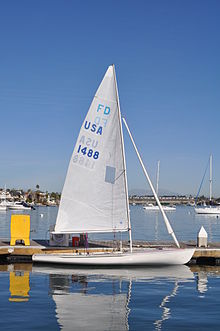Dinghy racing
IFDS works with yachting associations worldwide to run regional events all the way to the Paralympic Games, as well as adapt ISAF Racing Rules of Sailing to meet disability requirements.
After the starting signal, competitors are allowed to cross the line and begin to race to the next mark.
Some classes allow children to sail double handed until a particular age and then require them to compete single-handed.
Weight equalisation is also used on certain high-performance classes to ensure that comparative levels of performance are attained.
Other one-design classes such as the Europe and Flying Dutchman (1960 to 1992) allow differences in hull dimensions within certain tight tolerances.
Despite these tolerances only being intended to allow some leeway for boats built by different builders, this usually results in certain builders' boats being perceived as faster due to the way they make use of the tolerances to create a subtly different hull shape.
This type of one-design generally allows more freedom in choice of masts, sails and deck layouts.
Full development classes such as the International Moth and International C class catamaran represent the cutting edge of the sport, with fleets being very diverse and often using the latest ideas and technology, including hydrofoils and solid wings in place of sails.
Thomas Middleton proposed the idea of one design sailing punts, with centreboards all built and rigged the same in 1887.
The 49erFX is an identical hull to the men's 49er with a slightly reduced rig and sail area to accommodate lighter women's crews.
[2] Many secondary schools and universities worldwide have adopted dinghy racing as either a club or varsity sport.
They not only organize 6 large events each year but support teachers by using sailing as a way of making education interesting and fun.
However, for the purposes of large fleet racing with many different classes, the handicap systems seem to work quite well.
Keen club sailors join and compete in events with their State and National Associations.
Other competitive areas include the Eastern seaboard of the United States and Southern California.
Asia, Australia and South America are all large contenders at international events, Examples Motor-driven dinghy races include the Dinghy Derby in Australia, using aluminium boats that are variants of the Stacer 319 Proline type.

